J.R. Carpenter's Blog, page 8
September 10, 2011
Pondering an almost sanguine acceptance of a sudden and inconceivable absence
I am Canadian. Both my parents were American. I spent most of my summer vacations with my grandparents in New York City. They lived on the tenth floor of a fifteen-floor co-op apartment building in Queens. The bedroom windows had clear views of the twin towers. The North Tower was completed in December 1972, six months after I was born, and the South Tower was finished the month of my first birthday. I don't remember a time before them. I don't remember the view without them. I do remember my grandmother making disparaging remarks about them. Most New Yorkers did. They were harsh, they were brash. The New Yorkers were, I mean. The towers were impervious. Metal and glass. Modern. Gigantic. Purposelessly so, went the argument. Hundreds of commercial and industrial tenants, property owners, small businesses and residents were forcibly evicted to make way for them. And there they stood. Half-empty, at first, from what I understood. My mother had an office job in one of them once. My grandmother took me to the top of the other of them twice. From that square patch of high wind world the whole city seemed to shift and sway.
The evening of September 10, 2001, I decided to resign from the software company I was working at at the time. I was somewhat preoccupied when I arrived at the office the next morning. The one of my co-workers told me. The internet froze. I called my grandparents and couldn't get through. I called my cousin on Long Island. She knew all about it already, in that way that certain New Yorkers seem to know all about everything already. It was an accident, she informed me. It was an amateur pilot in a small plane, she went on the explain. Turn on the television, I implored her. I stood by my desk in Montreal listening to her listening to her television in her den in her huge empty house on Long Island. She was silent for a while, in a way I'd never heard her be before. And then: It's that Bin Ladan, she said. He hates us. Pause. I have to go. Click. I didn't hear from her again that day.
I was still standing by my desk holding the phone when the head of HR walked by. We need some televisions, I said. I need a television right now, I clarified. When I saw it, on television, I said, to whomever was standing next to me: My grandparents can see this from their bedroom window. It was evening by the time I got word from another cousin, stranded on the Jersey side of the Hudson, that my grandparents had spent most of the day in their car in a traffic jam on the BQE. It was slightly more complicated than that, but it was basically that. The circumstances of the day were so extraordinary that for two octogenarians to have spent all day in a car on a gridlocked highway constituted incredibly good news. They were on right side of the closed bridges. By right side I mean home side. They didn't see the planes hit from their bedroom window. They didn't watch the towers collapse from their bedroom window. By the time they got home, the towers were rubble and smoke.
The gap my grandparents experienced inside the bubble of their car, inside and yet outside of spectacle even as it was unfolding, may explain in part why, when I finally got hold of my grandmother, she sounded so utterly unfazed by the day's events. We're fine, she said. We went to donate blood. But they don't want it. So we're donating to charity instead. Not cheerful exactly. But impossibly matter of fact.
A few days later Mayor Giuliani said the best thing anyone could do for New York was spend money in it. I called my grandmother. Of course, you're always welcome here, she said. I bought a plane ticket. September 19, 2001. We circled once, before our final approach to Laguardia. We banked south west of the still soldering hole. For those of you on left hand side of the plane, the pilot said. I arrived at my grandparent's apartment at seven in the evening. A warm but somewhat bemused welcome. Now, she said, explain to us again why you're here? I tried to explain about how I needed to see for myself. There's nothing to see, she said, in a perfectly normal tone of voice. And anyway, the trains aren't running. People are walking, I said. I'd seen them on the news, streaming past City Hall in droves. There's no more City Hall, she said. Slowly, and by slowly I mean painfully, it dawned on me that, even eight days after one of most televised events in history, and despite the fact that she could still see lower Manhattan from her bedroom window, my grandmother, who lived the first thirty odd years of her life below Second Street, seemed to believe and to have calmly accepted that all of lower Manhattan was completely gone.

Ten years on and I still don't know what to make of this almost sanguine acceptance of a sudden and inconceivable absence. Surely it was shock induced. What do the philosophers have to say on this subject? Has Paul Virilio already written a book about just this sort of thing? I haven't done much in the way of research. Ten years on and I don't fully understand how or why or what or whom to mourn. The 2,977 civilians who died as a result of terrorist attacks on American soil; the 4474 men and women of the US military and the over 108,000 Iraqi civilians who have died as a direct result of the invasion and occupation of a nation which had nothing whatsoever to do with the attacks of September 11th; the the over $900 billion of US taxpayers' funds spent or approved for spending on Iraq rather than health care, education, housing, art or deficit reduction; or the sad fact that the executions of Saddam Hussein and Osama Bin Ladan have not improved the lives of American citizens in any way? All of these things at once. And many others.
My grandmother didn't die in a terrorist attack. She died in a heart attack. Days before the second US invasion of Iraq. After her funeral, back at her apartment, the family weighed in. Two cousins where for the invasion. One girlfriend agreed. The wife of a relative I'd only just met questioned me closely on the quality of life in Canada. In the event of a draft she intended to send her son north. The hawkish cousins scoffed at this. I pointed out that I was born in Canadian because my father evaded the Vietnam draft. The hawkish cousins insinuated that this proved their point. My grandfather was the only one in the room who had ever been to war. The Great War. The Pacific arena. He witnessed the razing of Manila. But no one sought his opinion. And anyway, he wasn't listening. For the past few days at intermittent intervals he'd been asking if anyone knew what had become of my grandmother's rings. He had given them to me himself. I was wearing them. I kept showing him my hands.
Tweet
September 1, 2011
Performing Digital Texts in European Contexts : A New Commentary Column on Jacket2
 Last night I started a new sustained writing project. For the next three months I will be a regular commentator for Jacket2, an online journal of modern and contemporary poetry and poetics associated with PennSound and the Kelly Writers House at the University of Pennsylvania in Philadelphia, Pennsylvania, USA.
Last night I started a new sustained writing project. For the next three months I will be a regular commentator for Jacket2, an online journal of modern and contemporary poetry and poetics associated with PennSound and the Kelly Writers House at the University of Pennsylvania in Philadelphia, Pennsylvania, USA.
I will be posting under the still somewhat tentative header, Performing Digital Text in European Contexts. In this space I will endeavour to collect, recollect and comment on a wide variety of digital texts and contexts operating in the inter-zones where digital media, literature, visual art and performance practices meet. My first post further outlines the kinds of texts and contexts I'm thinking of. Although, or rather because, I already have certain writers, works, venues, events and organizations in mind, I actively seek suggestions on others. If you or someone you know is performing digital texts in European contexts, please let me know through the contact information on the Jacket2 page.
Other recent Jacket2 commentators have included Oana Avasilichioaei, writing on experimental Canadian poetics in Folding Borders: Experimenting in the Canadian Laboratory, Eric Baus, writing on lesser known gems from the PennSound archive in Notes on PennSound, and Charles Bernstein, writing on, you know, the myriad and many things Charles Bernstein. Needless to say, I'm thrilled to join this company.
More information about Jacket2.
Performing Digital Text in European Contexts
Tweet
August 1, 2011
The Writer on Holiday
iam mens praetrepidans auet uagari,
iam laeti studio pedes uigescunt.
Exited thoughts now long to travel;
Glad feet now tap in expectation.
Catullus, XLVI
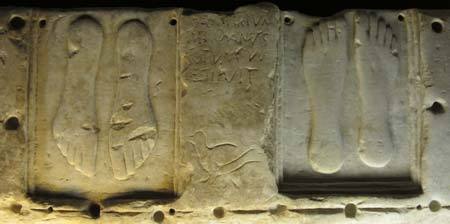
Very early Thursday morning I will board a ferry in Plymouth, England, bound for Roscoff, France, thus embarking on what in common parlance is known as a holiday, though I hesitate to call it one per se, having recently re-read Roland Barthes essay, The Writer on Holiday. According to Barthes the holiday is a recent phenomenon, linked to the rise of the worker class. How very proletarian a notion: the holiday with pay. How very bourgeois of the reader to acknowledge with parsimony the prosaic necessities of the proletarianized writer, "that this phenomenon can henceforth concern writers, that the specialists of the human soul are also subjected to the common status of contemporary labour."
"What proves the wonderful singularity of the writer, is that during the holiday in question, which he takes alongside factory workers and shop assistants, he unlike them does not stop, if not actually working, at least producing. So that he is a false worker, and a false holiday-maker as well. One is writing his memoirs, another is correcting proofs, yet another is preparing his next book. And he who does nothing confesses it as truly paradoxical behaviour, an avant-garde exploit, which only someone of exceptional independence can afford to flaunt. One then realizes, thanks to this kind of boast, that it is quite 'natural' that the writer should write all the time and in all situations. First, this treats literary production as a sort of involuntary secretion, which is taboo, since it escapes human determinations: to speak more decorously, the writer is the prey of an inner god who speaks at all times, without bothering, tyrant that he is, with the holidays of his medium. Writers are on holiday, but their Muse is awake, and gives birth non-stop." [Barthes 27]
Fortunately, as it would appear from Barthes that – whilst their presumably female Muses are giving birth non-stop – all writers are men, many of these problems may not apply to me. I fully intend to read relentlessly on my holiday, but only books in which nothing much happens. On 22 July 2011 The University of Chicago posted a video of the Pearl Anderlson Sherry Memorial Poet Lecture presented 29 March 2011 by Lyn Hejinian, who spoke – quite brilliantly, I thought – on time in Gertrude Stein's Lucy Church, Amiably. The title this early Stein novel refers to the site of both it's writing and of it's setting – Lucey, France. Gertrude and Alice purchased a holiday home in the region in 1926 or so. In the special perversity of writers in holiday homes, rather a lot of writing got done there. Discordant to the title of Hejinian's paper, Lateness: The Latitudes Lucy Chruch, Aimably, I ordered the novel immediately and am highly anxious to have it arrive before I leave.
I do worry over the involuntary secretion Barthes mentions. It is my ardent hope that this blog post siphons off whatever excess travel writing tenancies may have built up in my system so that I depart having already written of travel and return refreshed to write of home. There are of course other secretions as involuntary as no less embarrassing than literary production to contend with when travelling. Perspiration, in particular. We become unaccustomed to sweating in England. When we travel to warm places we sweat copiously and spill foreign food items on our clothing at a rate directly proportional to the amount of fresh laundry we have left in our suitcases. I can't remember where the narrator is travelling to in Lorie Moore's brilliant short novel Who Will Run the Frog Hospital? because I read the novel whilst travelling and now have no idea where it is or if indeed I ever owned a copy. False holiday-maker, copious note taker, wherever I was when I read this book I find now that I copied then this, the most relevant of all possible (in this context) involuntary secretion quotations:
"My body fights travel, sends up the weapons of a homeless person, the boundaries thinly drawn, the body with its own knowledge, disorientations, defences: the winy sweat, the cheesy shit."
In honour of Marshall McLuhan's 100th birthday 21 July 2011 I re-read Understanding Media, in which McLuhan argues many half-mad half presciently brilliant things. Among them, he states:
"The book reader has always tended to be passive, because that is the best way to read."
I completely disagree. In a typically proletarian writer on holiday way, even when I read for pleasure – a somewhat dubious distinction from the reading I do for research, which is almost entirely also done for pleasure – I read in a active, demanding, participatory, bordering on aggressive way. I underline passages, annotate margins, dog-ear pages, walk away, look stuff up, talk back to the book, talk about the book behind it's back, and, if the book is any good, steal its best bits. The [generalized] bourgeois "book reader" McLuhan and Barthes both refer to is obviously not a writer. The writer reads on holiday. And, since, for the [generalized] writer, reading is a vocation, in reading as in writing, there can be no vacation.
The world vacation comes from the Old French word vacation, from the Latin vacti, vactin-, freedom from occupation, from vactus, past participle of vacre, to be empty, at leisure. The current French word for vacation is vacances and – to hell with Barthes – come hell or high water (though hopefully not high water as the ferry journey is a long one), as of very early Thursday morning, to the best of my abilities, I plan to be en vacances.
WORKS CITED
Roland Barthes, "The Writer on Holiday," Mythologies,, NY: FSG, 1991
McLuhan, Marshall, Understanding Media, London: Routledge, 1964
Lorie Moore, Who Will Run the Frog Hospital?, NY: Warner Books, 1994
Tweet
July 16, 2011
Along the Briny Beach
My most recent piece of digital poetry, Along the Briny Beach, generates a coastline. The source code loads the following variables: Land Sea Write Erase Walk Liminal Space. The variable _Read_ is assumed to be client-side. The function _Writing and Erasing_ returns: Edges Ledges and Legible Lines caught in the Double-Bind of Writing and Erasing. Onload: Write Coast.

Along the Briny Beach appears in the new garden-theme issue of Boulder Pavement, an elegant multi-media journal published by The Banff Centre Press three times a year.
Along the briny beach a garden grows. With silver bells and cockleshells, cockles and mussels, alive, alive oh. A coral orchard puts forth raucous pink blossoms. A bouquet of sea anemones tosses in the shallows. A crop of cliffs hedges a sand-sown lawn mown twice daily by long green-thumbed waves rowing in rolling rows. The shifting terrain where land and water meet is always neither land nor water and is always both. The sea garden's paths are fraught with comings and goings. Sea birds in ones and twos. Scissor-beak, Kingfisher, Parrot, and Scissor-tail. Changes in the Zoology. Causes of Extinction. From the ship the sea garden seems to glisten and drip with steam. Along a blue sea whose glitter is blurred by a creeping mist, the Walrus and the Carpenter are walking close at hand. A pleasant walk, a pleasant talk along the briny storied waiting in-between space. Wind blooms in the marram dunes. The tide far out, the ocean shrunken. On the bluff a shingled beach house sprouts, the colour of artichoke. On the horizon lines of tankers hang, like Chinese lanterns. Ocean currents collect crazy lawn ornaments. Shoes and shipwrecks, cabbages and kings. Water bottle caps and thick white snarls of string. At dawn an ancient tractor crawls along the briny beach, harvesting the tide's leaves. The world's plastic, the sea's weeds.
Along the Briny Beach was performed in collaboration with Jerome Fletcher at E-Poetry [ 2011 ] : International Digital Language | Media | Arts Festival at SUNY Buffalo, Buffalo, NY, May 19, 2011.
The source code for the poetry generating component of Along the Briny Beach is based on Taroko Gorge, by Nick Montfort, other remixes of which appear in my recent book GENERATION[S].
Along the Briny Beach || Boulder Pavement 4
Tweet
July 5, 2011
Muddy Mouth, a new P.o.E.M.M. published in Speak, a sweet iPhone/iPad app
Muddy Mouth is a poem that plays with toponomy, homonymy, river sedimentology and various other ologys pertaining to the ways migration between English-speaking places named after other English-speaking places completely messes with one's ability to speak English. Muddy Mouth is also a P.o.E.M.M. Poems for Excitable [Mobile] Media is a series of poems exploring new writing and reading paradigms, written and designed to be read on mobile devices using touch interaction, created by Jason E. Lewis and Bruno Nadeau at Obx Labs in Montreal. The first P.o.E.M.M. app – available on iTunes since the spring – is called Speak. Speak is a series of poems about place, voice and the nature of poetry itself. Using the constraints laid down by the original Speak poem app, Lewis invited a number of poets to write new poems that responded thematically and formally to those constraints. Muddy Mouth is one of those poems.
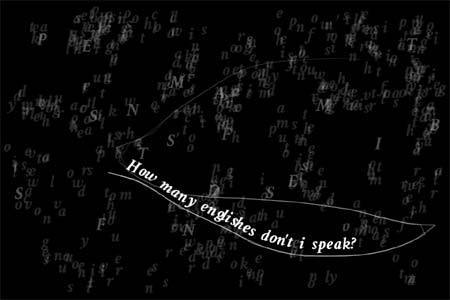
In the coming months Obx Lab plans to create a series of five P.o.E.M.M. apps, each exploring different interaction methods, collaboration strategies, and publication methods. The P.o.E.M.M.s are also part of a series of exhibition-scale interactive touch-works integrated with large-scale printed texts. To find out more about the P.o.E.M.M. project, visit www.poemm.net.
Download the Speak app from iTunes.
June 30, 2011
Writing Coastlines: Estuaries, Islands and Beaches as Liminal Spaces in the Writings of Elizabeth Bishop
Earlier in June I presented at a conference called "It must be Nova Scotia:" Negotiating Place in the Writings of Elizabeth Bishop, held at University of King's College, Halifax, Nova Scotia June 10-12, 2011.
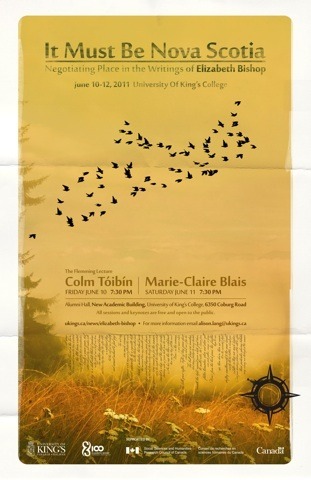
My paper examined instances in the writings of Elizabeth Bishop wherein coastlines are evoked in order to refer to a psychological subjective state – conscious or unconscious – of being on the threshold between places.
In her poem, "The Moose," Bishop writes a coastline of extreme contrasts to evoke the liminal condition of migration, of being in transition, of being of and in-between places, on a long bus ride along a coastal road stretching between home and away:
home of the long tides
where the bay leaves the sea
twice a day and takes
the herrings long rides,
where if the river
enters or retreats
in a wall of brown foam
depends on if it meets
the bay coming in,
the bay not at home;
where, silted red,
sometimes the sun sets
facing a red sea,
and others, veins the flats'
lavender, rich mud
in burning rivulets
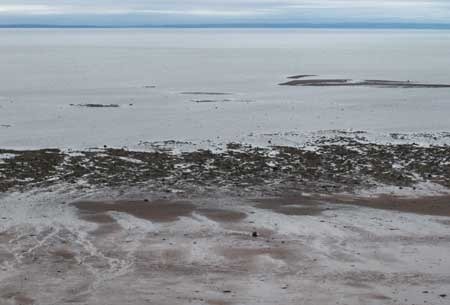
A red sea. Mud flats. Lavender water. Bishop uses strikingly similar language to describe a nearby coastline in her short story, In the Village:
There are the tops of all the elm trees in the village and there, beyond them, the long green marshes, so fresh, so salt. Then the Minas Basin, with the tide halfway in or out, the wet red mud glazed with sky blue until it meets the creeping lavender-red water…
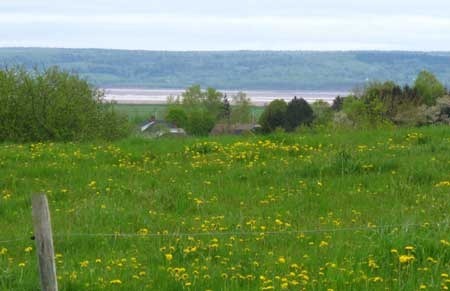
The site of this sight is geographically the furthest point from the epicentre of the story. The evocation of estuarine overlaps, mixtures and contradictions at this moment serves both to enunciate an internal emotional confusion within the narrator, and to project the narration beyond the geographical confines of the village.
We are in the "Maritimes" but all that means is that we live by the sea.
This liminal coastline writes a possible future, a point of departure, a line of flight. If all being "in the Maritimes" means is living by the sea then one can be in or from the Maritimes living by any sea. Indeed, Bishop wrote In the Village in Brazil, a place that reminded her of Nova Scotia but, importantly, most certainly was not.
I grew up in Nova Scotia. I left twenty-one years ago. I live in England now, which reminds me of Nova Scotia, but, importantly, most certainly is not. It was both delightful and terrifying to return to "narrow provinces / of fish and bread and tea" to present an academic paper to a conference of specialists. Good for the confidence, to have it come out well in the end.
For more information about the conference, view the program.
June 14, 2011
Electronic Literature Lo-fi Style: Where is it? What is it? How does it work?
This informal information session and hands-on workshop led by current Struts Open Studio artist in residence J. R. Carpenter will offer an introduction to the hybrid genre of electronic literature. Using examples from her recent work, J.R. will show how to remix and recycle found code to create new stories, poems and animations. Participants will create a short fiction generator together. A list of links to venues, journals and galleries publishing and exhibiting electronic literature will be offered, for your future reading pleasure. No programming skills required! No special equipment necessary. Bring a laptop if you have one. Bring a pen. Bring a friend.

Thursday , June 16, 2011, 7PM FREE
Struts Gallery, 7 Lorne Street, Sackville, NB
http://strutsgallery.ca
J. R. Carpenter has been using the internet as a medium for the creation and dissemination of non-linear narratives since 1993. She also makes zines, novels, maps, walks, photographs and performances of various kinds. More information about her projects can be found on her website: http://luckysoap.com
May 2, 2011
LEA New Media Exhibition: Re-Drawing Boundaries
Three of my web-based works are included in Re-Drawing Boundaries, a new online New Media Exhibition launched in April 2011 by Leonardo Electronic Almanac (LEA), the electronic arm of the pioneer art journal, Leonardo – Journal of Art, Science & Technology, published by MIT Press.
[image error]
Over a fifteen-week period Re-Drawing Boundaries will present a spectrum of recent and older works by an international selection of artists working in the emerging and often overlapping fields of Locative Media, New Media and Mapping. The exhibition aims to represent cross-pollination and progression between these works, artists and artistic territories.
In each of the three web-based narrative map works of mine to be featured in week ten of Re-Drawing Boundaries, maps operate – often simultaneously – as images, interfaces, and stand-ins for far-away places and pasts that could never be mine. My early adoption of the web as a narrative medium was due in part to my attraction to the internet as a place-less place. These web "sites" may be read as repositories for longings for belonging, for home.
Mythologies of Landforms and Little Girls [1996]
http://luckysoap.com/mythologies
The Cape [2005]
http://luckysoap.com/thecape
CityFish [2010]
http://luckysoap.com/cityfish
Re-Drawing Boundaries is curated by Jeremy Hight, with senior curators Lanfranco Aceti and Christiane Paul. The selected artists are:
Kate Armstrong, Alan Bigelow, Louisa Bufardeci, Laura Beloff, J.R Carpenter, Jonah Brucker Cohen, Vuk Cosic, Fallen Fruit, Luka Frelih, Buckminster Fuller, Rolf Van Gelder, Natalie Jeremijenko, Carmin Kurasic, Paula Levine, Mez, Lize Mogel, Jason Nelson, Christian Nold, Esther Polak, Proboscis, Kate Pullinger, Carlo Ratti, Douglas Repetto, Teri Rueb, Stanza, Jen Southern, Kai Syng Tan, Jeffrey Valance, Sarah Willams, Jeremy Wood, Tim Wright.
I'm thrilled to be in such great company.
For more information on this exhibition, visit: http://www.leoalmanac.org/index.php/lea/exhibition/lea_new_media_exhibition/
Download: LEA New Media Exhibition: Re-Drawing Boundaries Press Release (PDF)
Follow LEA on: Facebook, Flickr, Twitter, YouTube and Vimeo.
April 24, 2011
CityFish in soundsRite, a journal of online sound and writing, University of Western Sydney, Australia
CityFish has been published in Volume 3 of soundsRite, a journal of online sound and writing founded in 2009 by Hazel Smith and Roger Dean as an initiative of MARCS Auditory Laboratories and the Writing and Society Research Group, University of Western Sydney, Australia. soundsRite publishes selected new media work which includes words or sound or both, featuring sound works created for digital embodiment, including generative, interactive and multi-channel pieces, and showcasing writing which is kinetic, generative or interactive.

CityFish is a hybrid word, title of a hybrid work, tale of a hybrid creature. Part classical parable, part children's picture book, CityFish is a web-based intertextual hypermedia transmutation of Aesop's Town Mouse Country Mouse fable. Winters, a Canadian girl named Lynne freezes in Celsius in the fishing village of Brooklyn, Nova Scotia (Canada), a few minutes walk from a white sandy beach. Summers, she suffers her city cousins sweltering in Fahrenheit in Queens, New York (USA). By now Lynne knows everyone knows it's supposed to be the other way around. Lynne is a fish out of water. In the country, her knowledge of the city separates her from her school of friends. In the city, her foreignness marks her as exotic. Meanwhile, the real city fish lie in scaly heaps on long ice-packed tables in hot and narrow Chinatown streets. CityFish represents asynchronous relationships between people, places, perspectives and times through a horizontally scrolling browser window, suggestive of a panorama, a diorama, a horizon line, a skyline, a timeline, a Torah scroll. The panorama and the diorama have traditionally been used in museums and landscape photography to establish hierarchies of value and meaning. CityFish interrupts a seemingly linear narrative with poetic texts, quotations, Quicktime videos, DHTML animations, Google Maps and a myriad of visual images. Combining contemporary short fiction and hypermedia storytelling forms creates a new hybrid, a lo-fi web collage cabinet of curiosities. The story of Lynne and the city fish unfolds in this strange horizontally scrolling world of absences and empty spaces – furious, intimate, and surreal.
More information on CityFish: http://luckysoap.com/lapsuslinguae/category/cityfish/
CityFish on soundsRite: http://soundsrite.uws.edu.au/soundsRiteContent/volume3/JRInfo.html
April 17, 2011
Locating Struts Gallery: It's Somewhere Near Sackville, New Brunswick, on the Tintemar River, in Arcadia, Nouvelle France
In preparation for an upcoming five-week stint as artist-in-residence at Struts Gallery May 22 – June 25, 2011, I have been doing some remote location research. The noun location refers both to a physical place (site), and to the act of locating that place. The verb location refers to the identification or discovery a place or location. The location exists before it is located. The act of location sets, fixes and establishes the location's position, which is to say, provides a context for place. Location may be assigned by measurement, by survey, by knowledge, or by opinion. I locate the following act of locating Struts Gallery within the discourse of residency. Because knowing where you're going is not a prerequisite for travel. But knowing where you are arriving is helpful for staying.
Struts Gallery is located at 7 Lorne Street, Sackville, New Brunswick, the Maritimes, Atlantic Canada, Canada, North America, the Northern Hemisphere, the Western Hemisphere, the Western World, the G8, the G20, the Earth, the Solar System, the Milky Way, the Universe, etc.
The town of Sackville is located in Westmorland County, on the southern part of the Isthmus of Chignecto, which joins the peninsula of Nova Scotia to mainland New Brunswick. Sackville was first known as Pre des Bourgs and the surrounding region as Beaubassin by the Acadians who settled there in 1672. Pre des Bourgs, Beaubassin, Acadie, Nouvelle France, the New World, the Earth (which is round), the Solar System (which revolves around the Sun), etc.
According to Wikipedia the Beaubassin seigneury, granted in 1684, was named after Michael Leneuf de Beaubassin the elder (1640–1705), an officer in the French Navy who seized three English vessels from Boston that were taking on coal at Cape Breton. Beaubassin is a place named after a person named after a place, a location located withing the discourse of residency. Cape Breton is a place named in passing. According to the Dictionary of Canadian Biography Online, in a letter dated 8 July 1524, Giovanni da Verrazzano "records the earliest geographical and topographical description of a continuous North Atlantic coast of America derived from a known exploration." In the world map drawn by his brother Gerolamo da Verrazzano in 1529, the "land which the Britanni (Britons) found" is named Cape Breton.
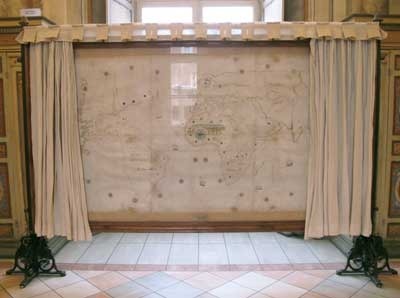
Gerolamo da Verrazzano, 1529, Vatican Museum. Photo: J. R. Carpenter, 2011
The naming of Cape Breton is relevant to the locating of Sackville because Sackville (Pres des Bourges) was once, and some would argue still is, in the heart of Acadie. According to Andrea di Robilant, the name Acadia may also be attributed to the Verrazzano brothers:
"Some linguists say the place name [Acadia] was derived from caddie/quoddie, a word used by native tribes to designate a fertile region. But others say it is not derived from a native term at all and that it was introduced into the language by Giovanni da Verrazzano in 1524: while sailing north of Chesapeake Bay, he called the coastal region Arcadia because it brought to his mind the pristine beauty of mythical Arcadia… Then the r was dropped when Verrazzano's diaries were transcribed, and Arcadia because Acadia or Acadie, as the French possessions along the coast of Canada were known."
Andrea di Robilant (2011) Venetian Navigators: The Voyages of the Zen Brothers to the Far North, London: Faber & Faber
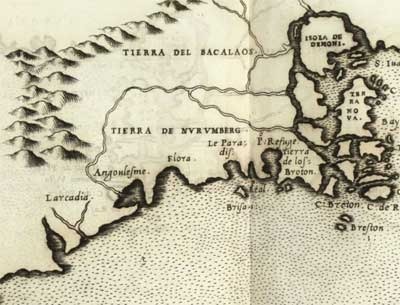
Girolamo Ruscelli, "Geografia di Claudio Tolomeo Alessandrino Tradotta di Greco nell'Idioma Volgare Italiano da Girolamo Ruscelli," published in Venice in 1561.
Italian brothers sailing for France give an ancient Greek name for a mythological place to a coast seen from a ship. In this act they (re)locate a previously existing (and thus, presumably, previously named) location within the discourse of Nouvelle France. Variations of Verrazzano's map were widely reproduced throughout the sixteenth century, with new place names added as they were discovered and altered as territorial ambitions grew. By the sixth edition of Ruscelli's Geografia, published in 1598, Nova Francia has been clearly etched in above larcadia, though the first permanent French settlement in North America was not founded by Champlain and Des Monts until six years later.
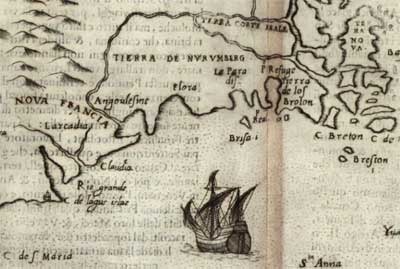
Girolamo Ruscelli, "Geografia di Claudio Tolomeo Alessandrino Tradotta di Greco nell'Idioma Volgare Italiano da Girolamo Ruscelli," published in Venice in 1598.
The French settlement at Port Royal was much further north than the stretch of coast the Verrazzano brothers had likened to Arcadia. Yet throughout the Voyages of Samuel de Champlain, published 1612, the name La Cadie is loosely used to refer to any French territory, most of which were also "fertile regions" – in the summer, at least.
"De Monts had obtained from Henry IV., though contrary to the advice of his most influential minister, a charter constituting him the king's lieutenant in La Cadie, with all necessary and desirable powers for a colonial settlement. The grant included the whole territory lying between the 4Oth and 46th degrees of north latitude. Its southern boundary was on a parallel of Philadelphia, while its northern was on a line extended due west from the most easterly point of the Island of Cape Breton, cutting New Brunswick on a parallel near Fredericton, and Canada near the junction of the river Richelieu and the St. Lawrence."
Samuel de Champlain, Voyages of Samuel de Champlain, Vol. 1: 1567-1635, translated from French by Charles Pomeroy Otis, Ph.D., Boston, November 10, 1880
Could Sackville be said to have roots in Arcadia? It is hard to say. The concept of Arcadia has always been a shifting one. The people who come to settle in La Cadie – a place named after another place named after a mythological place – become a people of La Cadie by dint of their residency in it. I will not become an Acadian by dint of a five-week stint as artist-in-residence at Struts Gallery. When the British expelled the Acadians from Acadie in 1755, their name became their nation and travelled with them. The meaning of all the named locations left behind changed.
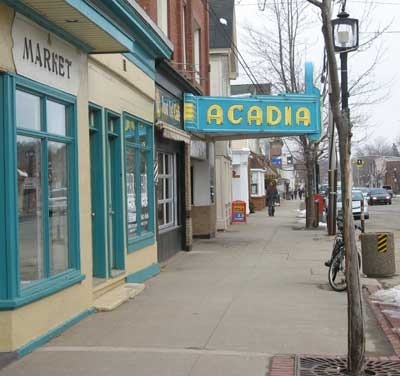
The Acadia movie theatre in Wolfville, Nova Scotia, home of Acadia University,formerly, my home town. J. R. Carpenter, 2008.
The region formerly known as Beaubassin is now called Tantramar. Sackville, New Brunswick, is located on a tributary of the Tantramar River, which feeds the Tantramar Marsh, which spreads inland from the Bay of Fundy for 10 kilometres. On a chart in Joseph Des Barres's Atlantic Neptune, published 1776, the Tantramar River is called the Tintamar. Tintamar is a Spanish word, meaning red sea. A Spanish name makes no sense given the history of this place. But the name Red Sea does. The Tantramar River flows into the Cumberland Basin which flows into Chignecto Bay which in turn flows into the Bay of Fundy, which has the highest tides in the world. When the tide goes out, it goes way out and keeps on going. It leaves behind salt marsh, salt hay thriving in hard, rich, sticky, red soil, and beyond that, red mud flats glistening mile after mile.
Elisabeth Bishop describes a similar scene in her 1953 short story, In the Village. The village in question is Great Village, Nova Scotia, 100 kilometres south of Sackville, New Brunswick. The Great Village river flows into Cobequid Bay, which empties into Minas Basin which meets up with Chignecto Bay in the Bay of Fundy.
"There are the tops of all the elm trees in the village and there, beyond them, the long green marshes, so fresh, so salt. The the Minas Basin, with the tide halfway in or out, the wet red mud glazed with sky blue until it meets the creeping lavender-red water… W are in the "Maritimes" but all that means is that we live by the sea."
Elizabeth Bishop, "In the Village," The Collected Prose, FSG, page 264.
Sitting in the British Library, in far away London, poring over massive first edition volumes of Des Barres's Atlantic Neptune, it is possible to entertain for a moment the idea that the name Tantramar is derived from the Spanish word Tintamar, assigned to that red mud glazed with sky by a cartographer of Spanish origin perhaps, or one who had previously written the coastlines of Spanish dominions.
More mundane research methods return equally fanciful results. Tintamar was most likely a miss-hearing. According to Wikipedia, the name Tantramar is derived from the Acadian French tintamarre, meaning 'din' or 'racket', a reference to the noisy flocks of birds which feed there. The marshes are an important stopover for migrating waterfowl such as semi-palmated Sandpipers and Canada Geese. Today the marshes are the site of two bird sanctuaries.
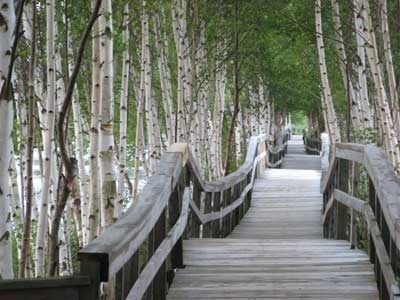
A walkway wending through the waterfowl sanctuary in the Tantramar Marsh near Struts Gallery, Sackville, New Brunswick, Acadia, Arcadia, Nova Francia. Photo: J. R. Carpenter, 2009
So far all my research suggests that Struts is located at the end of this walkway and the best way to get there is to walk this way.
On the Internet, Struts is located at: http://www.strutsgallery.ca/



